Acknowledgments
This project was funded by the United States Department of Agriculture (USDA), National Institute of Food and Agriculture, under agreement 2008-51130-19537, also known as the Southern Region Water Resource Project. The publication summarizes Florida results of a national project conducted by Robert Mahler, Professor of Soil and Environmental Sciences at the University of Idaho. The project was supported in part by the Southern Region Water Policy and Economics program team led by Michael D. Smolen, Oklahoma State University, Leeann DeMouche, New Mexico State University, and Donn Rodekohr, Auburn University. Damian Adams, University of Florida, and Alyssa Dodd, Department of Environmental Resources Management (Palm Beach County, Florida), were instrumental in the development of this survey. The authors also would like to acknowledge editorial suggestions for this publication by Diane Boellstorff, Sherry Larkin, Laila Racevskis, Carol Fountain, and Travis Prescott, University of Florida.
Introduction
This publication summarizes results of a public survey about actions to protect water resources in Florida. The survey solicited respondents' opinions about 13 practices to protect Florida water resources that can be aggregated into five categories: (1) urban practices, (2) practices for agricultural lands and open spaces, (3) preserving and protecting buffer zones and wetlands, (4) better management of shoreline access and recreational activities, and (5) improvements in education, monitoring of water quality, and data access. All practices were ranked as important / very important by the overwhelming majority of respondents with few exceptions. However, survey results depended on respondents' residence and socio-demographic characteristics. Specifically, more part-time Florida residents ranked some of the practices as not important / somewhat important, compared to year-around residents. Furthermore, more male respondents ranked the practices as not important / somewhat important. These differences in attitudes should be accounted for in the design of education / outreach programs.
2008–2009 Survey of Public in Florida
The purpose of the public survey titled Water Issues in Florida was to examine Florida residents' awareness and attitudes about water quality and quantity issues, as well as the strategies to protect state water resources.
The survey was mailed to 1,154 randomly selected Florida households in the fall of 2008 and spring of 2009; 523 households completed and returned the survey (45.5% response rate). The majority of survey respondents had at least a high school diploma (97%), were male (68%), and were at least sixty years old (60%). Most survey respondents resided in cities with populations of at least 25,000 residents (76%), had resided in Florida for at least five years (90%), and resided in Florida year-round (89%). In comparison with total Florida population, the survey respondents were comprised of a larger proportion of male, older, and more educated (Table 1). Such differences between the total Florida population and the sample of the survey respondents indicate that survey results may be affected by a non-response bias, i.e. that people who responded to the survey may be different from those who did not. As a result, survey results may not accurately reflect opinion of the state population as a whole (more information about the non-response bias can be found in EDIS publication PD008 by Glenn Israel [1992]). Unfortunately, non-response bias is typical for mail surveys (see, for example, Scott and Overton [1977]). To address the non-response bias, it was explored if responses to specific survey questions depended (in statistically significant way) on demographic characteristics of the respondents.
Actions to Protect Water Resources
Urban Practices
Survey respondents were asked to rank the importance of five practices that are usually implemented in urban areas: treating stormwater runoff, improving wastewater treatment, residential water conservation, improving home and garden practices, and building new water-storage structures (dams, reservoirs, etc.). All five practices were ranked as important / very important by the absolute majority of respondents (Table 2). However, among these five practices, residential water conservation and improving wastewater treatment were ranked as important / very important by the largest number of respondents (90% and 89%, respectively).
Surprisingly, 15 percent of respondents felt that improving home and garden practices is not important / somewhat important. Although this is a relatively small percent of respondents, this result still implies that even though almost all survey respondents perceive the importance of clean rivers, streams, marine waters, and groundwater (see EDIS document FE841, Public Attitudes about Water Issues in Florida), some respondents do not realize the effect of home and garden practices on these water resources.
The ranking of one of these urban practices—treating stormwater runoff—depended on respondents' age and residence characteristics. Specifically, the percentage of respondents who believed that this practice is important / very important was lower among respondents who reside in Florida part-time (58%), compared to year-round residents (81%, Figure 1) (chi-square test, 99 percent confidence level). In terms of age, fewer residents over 60 thought that this practice is important / very important (72%, compared to 87% of respondents between ages 50 and 60, Figure 2) (chi-square test, 99% confidence level). Such differences in survey responses led to two conclusions. First, special educational programs should be developed to educate part-time Florida residents about the importance of treating (and reducing) stormwater runoff, which can carry pollutants (such as nitrogen and phosphorus) into surface water or groundwater. Reducing and treating stormwater runoff can protect and improve the quality of Florida's water resources. Second, because respondents of the survey are older (in comparison with the total Florida population), the percentage of people who think that treating stormwater runoff is important may be higher than is implied by the survey results. No other statistically significant differences in responses among respondents of different age, sex, and residence characteristics were found.
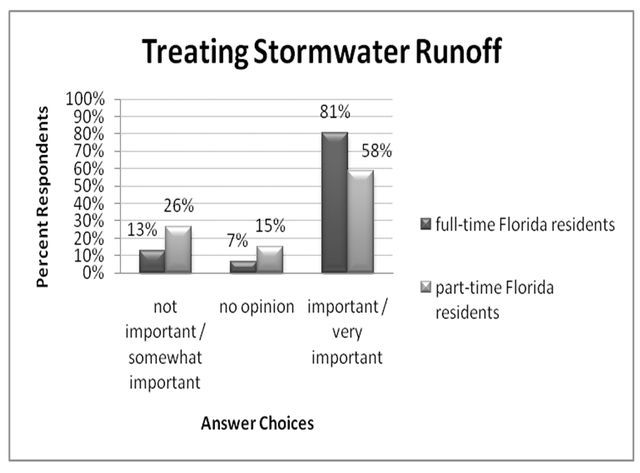
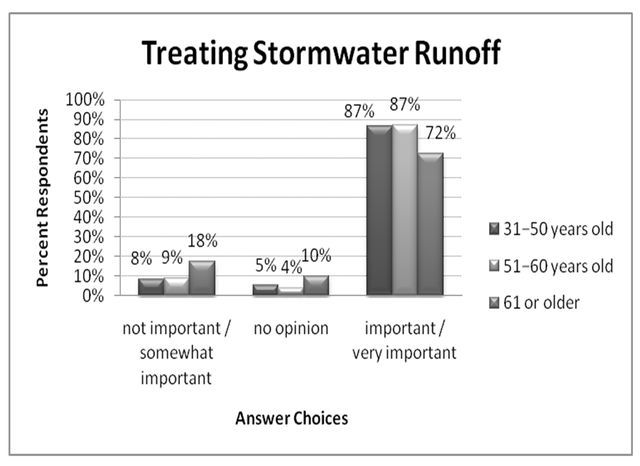
Agricultural Lands and Open Spaces
When asked about improving agricultural practices and about preserving agricultural lands and open spaces, the absolute majority of survey respondents indicated that these practices are important / very important (Table 3).
Responses about both practices depended on sex of the respondents. Specifically, a larger proportion of female respondents ranked both practices as important / very important, while a larger proportion of male respondents ranked these practices as not important / somewhat important (Figures 3 and 4). The differences in responses about these two practices among sex groups were statistically significant at the 99 percent and 95 percent confidence levels. It is concluded that the percentage of people who think that both these practices are important / very important may be higher than is implied by these survey results because the survey respondents are more likely to be male (in comparison with the total Florida population). No other statistically significant differences in responses among respondents of different age, sex, and residence characteristics were found.

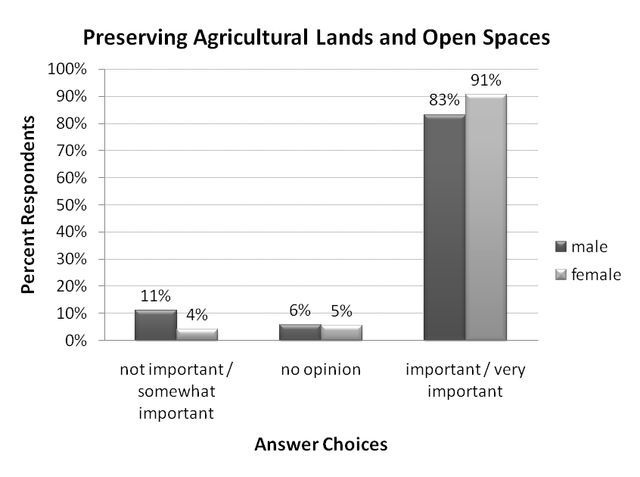
Buffer Zones and Wetlands
Preserving and restoring buffer zones and wetlands was important / very important to 83 percent of respondents (Table 4).
Interestingly, more respondents residing outside city limits assigned the not important / somewhat important ranking to this issue (14%), compared to respondents residing inside city limits (7%, Figure 5) (chi-square test, 95% confidence level). This result is alarming since respondents residing outside city limits may have greater abilities to contribute to preserving and restoring buffer zones and wetlands. However, overall, the majority of respondents living inside or outside city limits believe that this practice is important / very important.
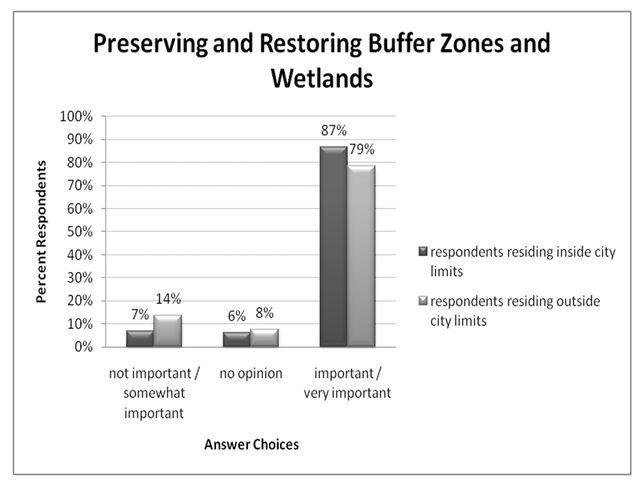
Furthermore, relatively many part-time Florida residents felt that preserving and restoring buffer zone and wetlands is not important / somewhat important (19%), compared to year-round residents (9%, Figure 6) (chi-square test, 95% confidence level). These results indicate that part-time Florida residents need more information about the importance of wetlands and buffer zones for protecting and improving surface water and groundwater quality, flood control, groundwater recharge, and wildlife habitat.

Finally, more male respondents ranked preserving and restoring buffer zones and wetlands as not important / somewhat important (12%), compared to female respondents (5%, Figure 7) (chi-square test, 95% confidence level). Since, on average, respondents of the survey were more likely to be male (in comparison with the total Florida population), the percentage of people who think that this issue is important / very important may be higher than is implied by the survey results.
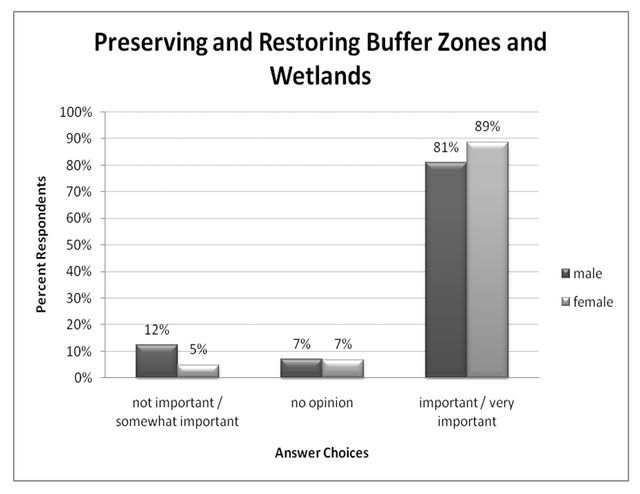
No other statistically significant differences in responses among respondents of different age, sex, and residence characteristics were found.
Shoreline Access and Recreational Activities
Better management of shoreline access to prevent erosion was perceived as important by 81 percent of the respondents (Table 5). Similarly to the results reported above, female respondents ranked better management of shoreline access as important / very important more frequently than male respondents (89% females versus 78% males; Figure 8) (chi-square test; 95% confidence level). A relatively large percent of respondents without high school diplomas had no opinion about the issue (12%; Figure 9) (chi-square test; 95% confidence level). Further research is needed to explain such difference in responses. No other statistically significant differences in responses among respondents of different age, sex, and residence characteristics were found.
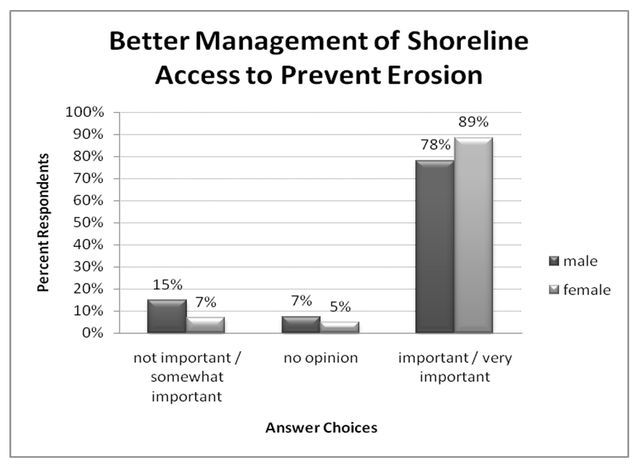
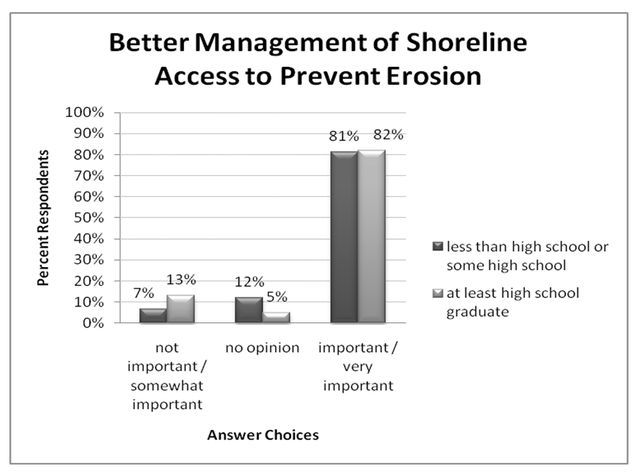
The differences in responses among people of different educational levels and sexes imply that the survey results may understate the percent of people in Florida who support better management of shoreline access (since on average, respondents of the survey are more likely to be male and more educated, in comparison with the total Florida population).
In turn, better management of recreational activities was perceived as important / very important by 78 percent of the respondents (Table 5). Similar to the results for other survey questions, female respondents ranked this issue as important / very important more frequently than male respondents (Figure 10) (chi-square test, 95% confidence level). No other statistically significant differences in responses among respondents of different age, sex, and residence characteristics were found.
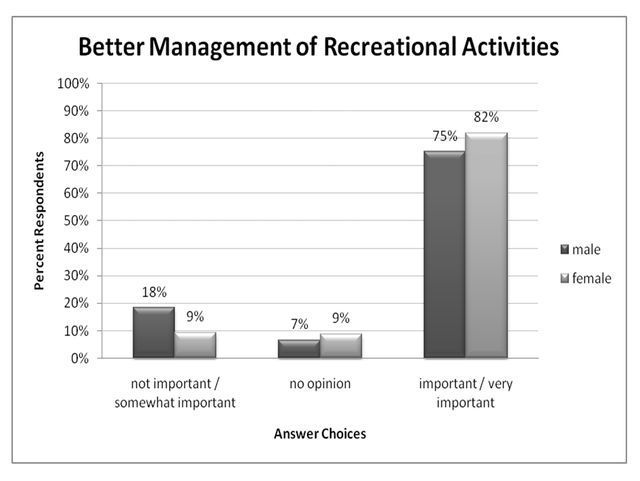
Along with improving home and garden practices, this action was ranked as not important / somewhat important by a relatively large number of respondents (a little more than 15%). This result may indicate that while respondents feel that protection of water resources is important, they do not understand the effects of their individual actions on these resources.
Educating Municipal Officials, Water Quality Monitoring, and Data Access
Ninety-two percent of surveyed respondents felt it was important / very important to improve water quality monitoring to detect pollution (Table 6). Furthermore, 88 percent of those surveyed thought it was important / very important to educate municipal officials. Surprisingly, 10 percent of respondents felt that it was not important / somewhat important to make water quality and quantity data public information despite public participation in policy decisions being emphasized and encouraged by state and federal agencies (Green 2003).
Respondents' residence and sex correlated with the answers they selected for this group of issues. Specifically, respondents residing outside city limits ranked the issue of improving water quality monitoring as not important / somewhat important relatively frequently (8% compared to 2% of respondents residing inside city limits, Figure 11) (chi-square test, 95% confidence level). However, overall, the overwhelming majority of respondents from both residence groups felt the issue is important / very important.
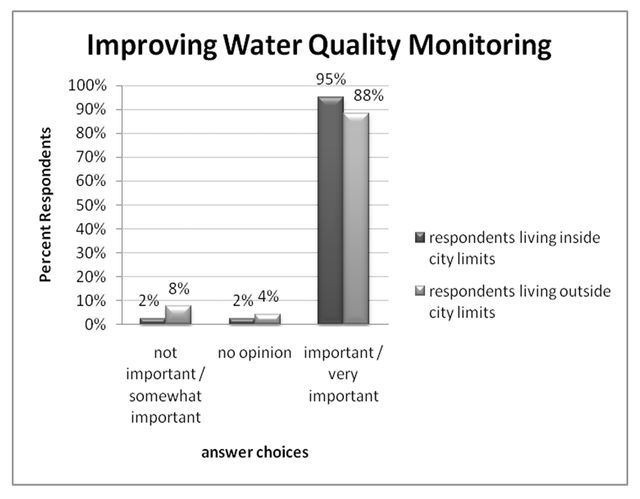
Furthermore, part-time Florida residents (19%) perceived the issue of making water quality and quantity data public information as not important / somewhat important more frequently than full-time residents (8%) (chi square test, 95 % confidence level (Figure 12). This result indicates that part-time Florida residents may be relatively less interested in the state of Florida's water resources. It can be a significant challenge for extension professionals to reach such audiences.
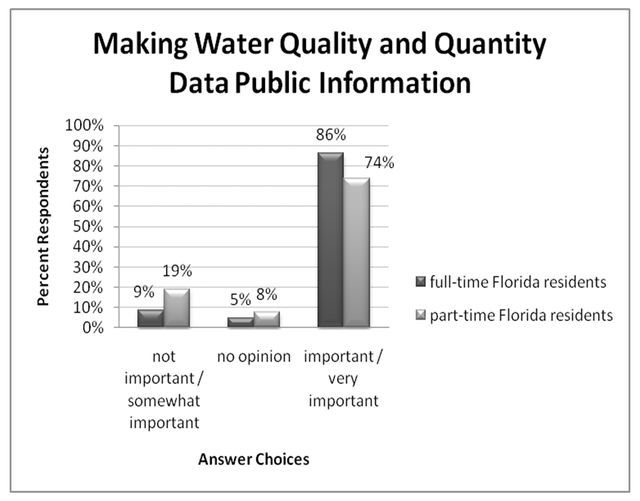
No other statistically significant differences in responses among respondents of different age, sex, and residence characteristics were found.
Conclusions
This publication summarizes results of a public survey about actions to protect Florida water resources. Respondents were asked about the importance of 13 categories of practices commonly used to maintain and improve water quality and availability. All these categories were ranked as important / very important by overwhelming majority of respondents. Respondents were especially supportive of the practices to improve water quality monitoring and to encourage residential water conservation. More than 90 percent of respondents believed these practices to be important / very important. The greatest number of respondents (about 15%) selected not important / somewhat important answer choices for the practices related to improving recreational activities and improving home and garden practices, and selected no opinion for building water storage structures.
Survey responses depended on residence and socio-demographic characteristics of citizens, such as length of residency in Florida, sex, age, and others. Because perceptions and attitudes are shown to vary across these characteristics, it is important to consider these variations when designing education and outreach programs to effectively reach across diverse demographic groups.
Specifically, more full-time Florida residents perceived that treating stormwater runoff, preserving and restoring buffer zones and wetlands, and making water quality and quantity data public information are important / very important issues, compared to part-time residents (who more frequently thought that these issues are not important / somewhat important). Because many part-time Florida residents spend several months every year in Florida, their actions and behaviors can significantly impact Florida water resources. Hence, special efforts should be made to reach this audience with Extension and other outreach programs.
Slightly more respondents living outside city limits ranked the issues of preserving and restoring buffer zones and wetlands, and improving water quality monitoring as not important / somewhat important, compared to respondents residing inside city limits. Further research is needed to explain this difference.
Finally, the survey results may slightly understate the ranking of importance for the practices. Specifically, survey respondents are more likely to be male, older, and higher educated than the average Florida resident. The survey results may be slightly biased since more male respondents than female respondents ranked the practices as not important / somewhat important. Similarly, for some practices, older and/or more educated respondents selected not important / somewhat important rankings more frequently than did younger and/or less educated respondents. The effects of demographic and residence characteristics on respondents' perceptions of various actions to protect water resource should also be accounted for in the design of education/outreach programs.
References
Green, C.H. 2003. Handbook of Water Economics: Principles and Practice. Chichester, West Sussex, UK: John Wiley and Sons, Inc.
Israel, G. 1992. Phases of data analysis. Electronic Data Information Source (EDIS) PD001. Gainesville, FL: UF/IFAS. https://edis.ifas.ufl.edu/pd001
SAS. 2010. SAS: The Power to Know. Cary, NC: SAS Institute, Inc. https://www.sas.com/en_us/home.html
US Census Bureau. 2008. 2006–2008 American Community Survey 3-Year Estimates. S1501. Educational Attainment. Florida. United States Census Bureau, Washington, D.C. http://factfinder.census.gov/servlet/STTable?_bm=y&-qr_name=ACS_2008_3YR_G00_S1501&-geo_id=04000US12&-context=st&-ds_name=ACS_2008_3YR_G00_&-tree_id=3308&-_lang=en&-format=&-CONTEXT=st
U.S. Census Bureau. 2000. Profile of General Demographic Characteristics: 2000. Florida. United States Census Bureau, Washington, D.C. https://www.census.gov/library/publications/2001/dec/2kh.html. Accessed October 13, 2022.